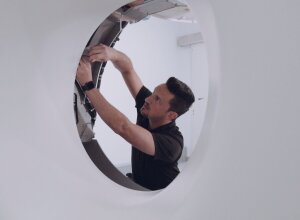by
John R. Fischer, Senior Reporter | August 08, 2023

Photo courtesy of United Imaging Healthcare
Maintaining a CT scanner throughout its lifetime is more than just diagnosing problems and deploying the right staff and tools to address them. Any service professional will tell you; medical equipment is no longer a “break-fix” industry, successful practices are preventing problems from happening in the first place.
For example, the failure of a CT tube can put a scanner out of commission for days or weeks until the part can be replaced. The cost of that downtime to a facility’s bottom line can be enormous. Today, investment in technologies like remote monitoring, combined with advancements in logistics, is allowing service providers to detect a tube failure before it happens.
While some hospitals and health systems perform CT scans all day, every day, others have downtime baked into the schedule, and still others may rarely use them but require they be ready in emergencies. An effective servicing plan will take into account utilization patterns, as well as other unique factors. HCB News sat down with four major CT original equipment manufacturers (OEMs) to discuss those key service considerations, and how providers can get the right plan for their needs.



Ad Statistics
Times Displayed: 174461
Times Visited: 3181 For those who need to move fast and expand clinical capabilities -- and would love new equipment -- the uCT 550 Advance offers a new fully configured 80-slice CT in up to 2 weeks with routine maintenance and parts and Software Upgrades for Life™ included.
Choosing the right service provider
Unsurprisingly, financial margins are a key factor influencing an organization’s decision on the type of service they seek for CT maintenance. For instance, while large, academic healthcare facilities often have the means to hire the manufacturer to oversee scanner maintenance, rural and small providers may be more inclined to go with independent service organizations, many of which can provide dependable services at lower costs, (we will look at independent servicing more closely in an upcoming article). Additionally, providers with well-trained HTM teams may prefer to keep certain aspects of CT service in-house that others could not.
Providers need to remember that certain servicing needs can sometimes best be handled by the OEM, according to Hani Chohan, vice president for service growth for the U.S. and Canada region at GE HealthCare. Therefore, it’s critical to consider not just the costs of service but also the quality and impact it will have on patient care long-term.
“Let's say a former healthcare employee went to work with some of these ISOs but their training on that GE HealthCare CT equipment was 10 or 15 years ago, he said. “Customers have the right to choose who they want to work with, and are encouraged to work with ISOs that have the right training and right access to compliant OEM parts.”

